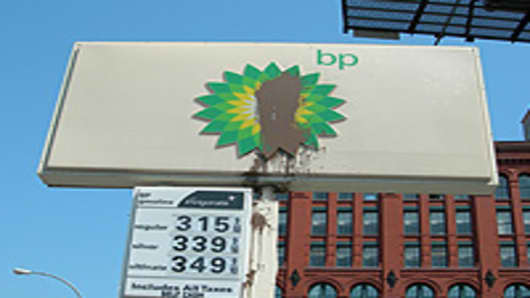Staring day after day at images of oil billowing from an undersea well in the Gulf of Mexico, many Americans are struggling to make sense of the numbers.
On Monday, BP said a cap was capturing 11,000 barrels of oil a day from the well. The official government estimate of the flow rate is 12,000 to 19,000 barrels a day, which means the new device should be capturing the bulk of the oil.
But is it? With no consensus among experts on how much oil is pouring from the wellhead, it is difficult — if not impossible — to assess the containment cap’s effectiveness. BP has stopped trying to calculate a flow rate on its own, referring all questions on that subject to the government. The company’s liability will ultimately be determined in part by how many barrels of oil are spilled.
The immense undersea gusher of oil and gas, seen on live video feed, looks as big as it did last week, or bigger, before the company sliced through the pipe known as a riser to install its new collection device.
At least one expert, Ira Leifer, who is part of a government team charged with estimating the flow rate, is convinced that the operation has made the leak worse, perhaps far worse than the 20 percent increase that government officials warned might occur when the riser was cut.
Dr. Leifer said in an interview on Monday that judging from the video, cutting the pipe might have led to a several-fold increase in the flow rate from the well.
“The well pipe clearly is fluxing way more than it did before,” said Dr. Leifer, a researcher at the University of California, Santa Barbara. “By way more, I don’t mean 20 percent, I mean multiple factors.”
Asked about the flow rate at a news conference at the White House on Monday, Adm. Thad W. Allen, the Coast Guard commander in charge of the federal response to the spill, said that as BP captured more of the oil, the government should be able to offer better estimates of the flow from the wellhead by tracking how much reaches the surface.
“That is the big unknown that we’re trying to hone in and get the exact numbers on,” Admiral Allen said. “And we’ll make those numbers known as we get them. We’re not trying to low-ball it or high-ball it. It is what it is.”
Speaking at a briefing in Houston on Monday, Kent Wells, a BP executive involved in the containment effort, declined to estimate the total flow and how much it might have increased. He said that video images from the wellhead showed a “curtain of oil” leaking from under the cap.
“How much that is, we’d all love to know,” Mr. Wells said. “It’s really difficult to tell.”
He said that more than 27,000 barrels of oil had been collected, and that engineers were working to optimize the collection rate.
On Sunday, engineers halted their efforts to close all four vents on the capping device, because even with one vent closed, the amount of oil being captured was approaching 15,000 barrels a day, the processing capacity of the collection ship at the surface.
Mr. Wells reiterated that a second collection system, involving hoses at the wellhead, would be implemented “by the middle of June.” That oil would be collected by another rig with the ability to handle at least 5,000 barrels a day, he said.
The success of the containment device has cast new doubts on the official estimates of the flow rate, developed by a government-appointed team called the Flow Rate Technical Group. Before the riser pipe was cut, the group made estimates by several methods, including an analysis of video footage, and the overlap of those estimates produced the range of 12,000 to 19,000 barrels a day that the team reported on May 27. That was two to four times as high as the government’s previous estimate of 5,000 barrels a day, a number that had been widely ridiculed by scientists and advocacy groups.
Yet the scientists who produced that new range emphasized its uncertainty when they presented it. In fact, a subgroup that analyzed the plume emerging at the wellhead could offer no upper bound for its flow estimate, and could come up with only a rough idea of the lower bound, which it pegged at 12,000 to 25,000 barrels a day.
The Flow Rate Technical Group is scheduled to release a new estimate this week or early next, though it is not clear whether that report will take into account the changed circumstances of recent days.
Some scientists involved in the Flow Rate Technical Group say that they would like to produce a better estimate, but that they are frustrated by what they view as stonewalling on BP’s part, including tardiness in producing high-resolution video that could be subjected to computer analysis, as well as the company’s reluctance to permit a direct measurement of the flow rate. They said the installation of the new device and the rising flow of oil to the surface had only reinforced their conviction that they did not have enough information.
“It’s apparent that BP is playing games with us, presumably under the advice of their legal team,” Dr. Leifer said. “It’s six weeks that it’s been dumping into the gulf, and still no measurements.”
President Obama has repeatedly criticized BP’s handling of response efforts. He has been criticized for his seeming lack of outrage over the spill, but he took an angrier tone Monday in an interview to be broadcast Tuesday morning on NBC’s “Today” show.
“I don’t sit around just talking to experts because this is a college seminar,” Mr. Obama told the show’s host, Matt Lauer, in an interview in Kalamazoo, Mich. “We talk to these folks because they potentially have the best answer so I know whose ass to kick.”
On Monday, Mr. Wells, the BP executive, said that engineers had always felt that the oil traveling through the damaged riser created some back pressure that reduced the flow rate. “We always expected to see some increase in flow” when the riser was cut, he said. “It’s difficult to do any calculations on that.”
The company, which for several weeks had publicly rejected the idea of using subsea equipment to measure the flow rate, now says it is up to the flow-rate group itself to decide whether to undertake such a step.
“We are fully cooperating with the Flow Rate Technical Group,” said Anne Kolton, a spokeswoman for BP. “We are working very closely with their experts.”
The difficulty adds one more item to the government’s long to-do list as it begins planning its response to future oil spills: creating some kind of technology that can produce accurate numbers in a deep-sea blowout.
The lack of a reliable measurement system “opens the door to all this speculation and uncertainty,” said Elgie Holstein, oil spill coordinator for the Environmental Defense Fund, an advocacy group, “and we’re all reduced to staring at grainy video footage from the ocean floor.”
The success of the cap has prompted commentators on cable networks and the Internet to ask what BP intends to do with the oil, whether the company should be allowed to profit from it or even whether the federal government should confiscate it.
BP officials have said previously that they intend to refine the oil and sell it, although the oil may require special handling. They have also pointed out that any money to be made — at current prices the oil collected by the cap so far would be worth about $1.9 million — would pale in comparison with the costs of the spill, currently $1 billion and counting.



